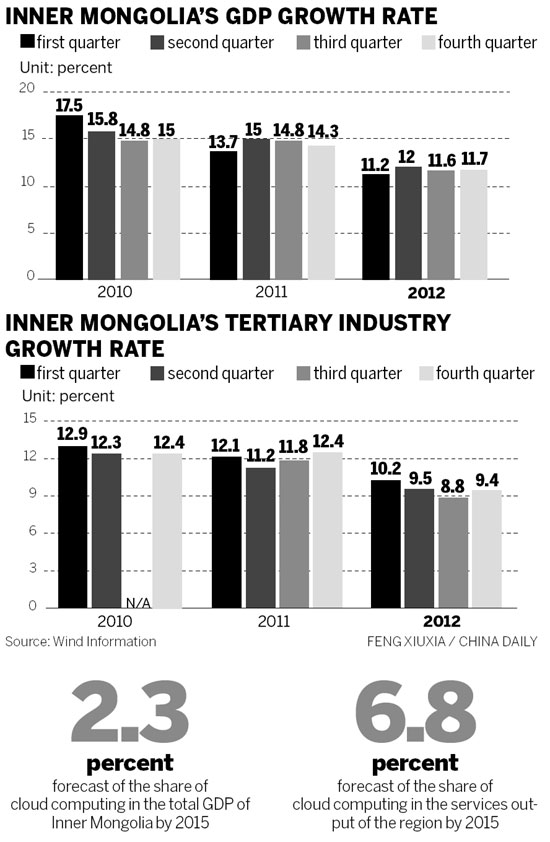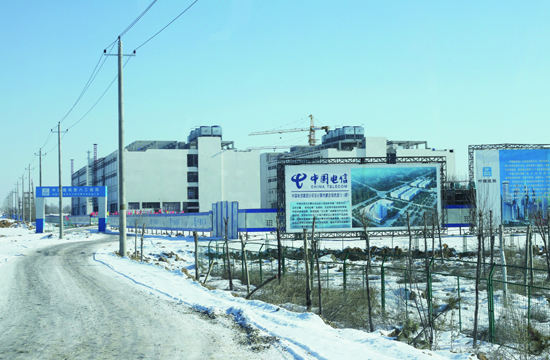Coal-rich region looks to 'clouds' for growth
The Inner Mongolia autonomous region, China's biggest coal producer, is aiming to transform its growth model through the construction of the country's largest cloud-computing industry base, report Wang Hao, Chen Jia and Yang Fang in Hohhot
Endless grassland and beautiful clouds are the iconic scenes of the Inner Mongolia autonomous region in northern China. Now a new kind of "cloud" is attracting more attention.
Hohhot, the regional capital, is emerging as the country's most important cloud-computing center.
After driving eastward half an hour from downtown Hohhot, wide new plots of land ready for large construction projects can be seen.
With the temperature lower than -10 C in the middle of winter, snow lies thick on the ground.
Construction workers had left the building site and returned home two weeks before the Spring Festival, leaving a large unfinished five-story building.
From outside, looking at the French windows, the building looks similar to other grandiose assembly halls in China.
"Here may be the heart of China's largest e-commerce company Alibaba in the future," said Hao Lianzeng, head of the Hongsheng Industrial Park, pointing to the new building.
The "heart" which Hao referred to is the cloud-computing center formed by server clusters being constructed by China Unicom, one of the three major telecom operators in China.
Upon its completion, the center will be able to provide data storage, processing and transmission services for hundreds of Internet businesses, said Hao.
"IT companies will be able to rent the servers from telecom operators, which is the basic business model," he said.
A cloud-computing platform is a flexible system that enables companies to design, launch and manage customized applications supported by a global or regional network of data centers.
Applications on the public cloud can be integrated and users are able to share information.
The fast computing and large storage capacity can help upgrade IT companies' research and development capabilities and cut operating costs, according to analysts.
Hohhot's project was launched in May 2012, when China Unicom announced plans to build a massive information industry base in the city with a cloud-computing center, an Internet data center and an enterprise data center.
A report from the company said that it planned to invest around 12.3 billion yuan ($1.9 billion) over the next 10 years in the construction of the cloud-computing project.
The project, in the Hongsheng Industrial Park, covers an area of 65 hectares, with a construction area of 598,000 square meters.
China Unicom Vice-President Zhang Junan said that the center will be one of the most advanced and environmentally friendly information and communication bases in the country.
One reason for the company to choose Hohhot as the center's location is that its Inner Mongolia subsidiary owns an 859-gigabyte international border communication network, making it China's largest exporter of telecommunication transmissions crossing the land border and giving it a vital advantage in connecting with the rest of the world.
The infrastructure construction and operation of the cloud-computing system require a great deal of electricity. Compared with other parts of China, Inner Mongolia, the nation's largest coal producer, can offer a relatively lower electricity price.
In addition, the relatively cheaper land, stable geological conditions and cool weather have also helped this region win favor from the telecom giant.
China Telecom Corp and China Mobile Ltd, the nation's two other biggest telecom operators, have also released cloud-computing blueprints for Hohhot, with planned investments of 12 billion yuan each.
New computing paradigm
In 1997, cloud computing was first described as a system that relies on the cooperation of computers.
At the time, US IT Professor Ramnath Chellappa suggested that the cloud would be a new "computing paradigm where the boundaries of computing will be determined by economic rationale rather than technical limits alone".
In 2006, Amazon.com Inc launched Amazon Simple Storage Service, one of the world's earliest online storage services, based on the idea of cloud computing.
The world's major IT players, including Microsoft Corp and Google Inc, have focused development strategies on cloud platforms, seeing it as an important way to maintain their competitive edge.
Chinese companies started exploring the potential offered by cloud computing in 2008.
Jack Ma, chief executive officer and chairman of China's e-commerce giant Alibaba Group Holdings Ltd, said in 2011 that it would develop a cloud-computing based operating system for smartphones.
It is reported that Ma recently visited Hohhot and talked with Nashun Menghe, Hohhot's Party chief, about the next stage in his company's cloud-computing center development plan.
It may be a good choice for Alibaba's major units, online retailer Taobao and its business-to-customer Tmall, to locate its data storage and transmission center in the Hohhot "cloud", Nashun said.
Alibaba's two online marketplaces account for more than 70 percent of the country's onlineretail market, with sales reaching 1 trillion yuan in the first 11 months of last year.
On Nov 11, Taobao and Tmall recorded single-day sales volume of 19.1 billion yuan. Its booming orders and online payment demand pushed the group to find a more powerful data center to support its rapidly expanding business.
"A stable and fast data processing system requires large groups of servers and uninterrupted power transmission, which can be provided here," Nashun said.
According to Nashun, Baidu Inc and Tencent Holdings Ltd have also expressed interest in Hohhot's cloud-computing industry.
A development plan released by the government of Inner Mongolia in December 2011 said that more cloud-computing centers will be launched by the end of 2013 in Hohhot, Baotou, Erdos and Chifeng.
"By then, the preliminary industry layout will be formed," according to the plan.
The regional government said that around 1 million square meters of cloud-computing centers would be constructed in the region by 2015, with around 1 million servers.
By that date, according to the government's plan, the region's cloud-computing industry is expected to have an annual income of 50 billion yuan and pay 15 billion yuan in taxes.
Chen Manli, a member of the region's political advisory body, said that Inner Mongolia planned to invest more than 77 billion yuan to support the development of the cloud-computing industry.
"Until now, 11 main projects have been launched and the investment has reached 55.27 billion yuan," Chen said.
She added that the industry is currently at a crucial stage of its growth, and it deserves much stronger backing.
The cloud-computing industry is expected to greatly increase and stabilize the service industry's output value, in the energy, modern manufacturing, smart city construction and public services management sectors, according to Chen.
"It will be more helpful for small-scale businesses that lack the capacity for independent research and investment in IT," she added.
"The launch of the new centers in Inner Mongolia will improve the regional development of high-tech information industries and optimize the economic structure of the autonomous region," said Hohhot top official Nashun.
"One of the key factors to facilitate the new technology-based development model is to attract and retain talent, and advanced industry can also help to improve the local employmentsituation," he said.
China's 12th Five-Year Plan (2011-15), released in March 2011, introduced a clear-cut policy to support the nation's IT and other emerging industries.
The Ministry of Science and Technology later said that China will build self-developed cloud-computing technology be the end of 2015.
More than 20 provinces and autonomous regions had released cloud-computing industry development plans by 2011.
The next three to five years will see tremendous demand in China for cloud computing, thanks to the nation's huge market of more than 550 million netizens and millions of IT companies, said a report from Chinese IT industry think tank CCWResearch.
It said that Chinese companies had invested around 18.8 billion yuan in new cloud-computing facilities in 2012, an increase of 48.1 percent year-on-year, while investment in cloud-related services reached 94.7 billion yuan.
The industry is likely to provide around 5 million job opportunities and more than 2.2 trillion yuan in production value across different industries over the next four years, said the report.
Economic transformation
Inner Mongolia's GDP increased to 1.6 trillion yuan in 2012, up 11.7 percent year-on-year, ranking it 15th among 31 provinces, autonomous regions and municipalities, according to theNational Bureau of Statistics.
The region's growth rate was 3.9 percentage points higher than the national average of 7.8 percent.
Inner Mongolia's industrial sector, which relies heavily on coal and minerals, accounted for 56.5 percent of the region's GDP, compared with 34.4 percent from the services sector and 9.1 percent from agriculture, according to the bureau.
Investment in Inner Mongolia's energy sector rose 6.8 percent year-on-year between January and November 2012, slowing from 13.6 percent in the same period in 2011, and accounting for 31.6 percent of total industrial investment, according to official data.
If the region's services sector can maintain an annual growth rate of 10 percent over the next three years - it grew 9.4 percent year-on-year in 2012 - cloud computing is likely to account for 6.8 percent of the region's services output value and 2.3 percent of regional GDP by 2015.
The shift in the energy-rich region's economic growth pattern is in line with the country's primary task for 2013.
China, the world's second-largest economy, ended 2012 with its slowest economic growth ratein 13 years - 7.8 percent, down from 9.3 percent in 2011.
Economic rebalancing, rather than chasing an excessively high growth rate, will be the government's focus over the next decade.
Sustainable growth should be based on energy conservation and emissions reduction, as well as environmental protection, the new leadership said after the 18th National Congress of the Communist Party of China in November.
The State Council, China's cabinet, approved an energy consumption control target on Jan 30 as part of the country's efforts to correct over-consumption and foster greener growth.
The government aims to keep total energy consumption below 4 billion metric tons of standard coal equivalent by 2015, with electricity consumption below 6.15 trillion kWh, according to a statement released by the State Council.
This means that average annual energy consumption growth should be around 4.3 percent between 2011 and 2015, lower than the 6.6 percent annual increase between 2006 and 2010.
"Inner Mongolia's economic development can no longer depend on the excessive exploitation of coal and mineral resources," said Nashun, top official of Hohhot.
"Cloud-computing technology can promote the upgrading of traditional industries," he added.
Jiang Guangzhi, an analyst from the Beijing Municipal Commission of Economy and Information Technology, said that China's cloud-computing infrastructure will be concentrated in energy-rich and high-latitude areas.
"Inner Mongolia will be the most important cloud-computing data center in China," Jiang said.
Chen Manli, the local political advisor, said the "cloud", which helps to transform electricity on-site into IT services, can help to cut pollution.
"Besides building the cloud data centers' hardware, the business management model is still not mature," said Chen. "Related service applications should be improved along with the basic construction."
So far, the public cloud-computing platform investment and profit allocation model is unclear, and China has yet to offer a successful example of this.
Wang Kaihao and Chen Limin contributed to this story.
Contact the writers at yangfang@chinadaily.com.cn


Comments
Post a Comment